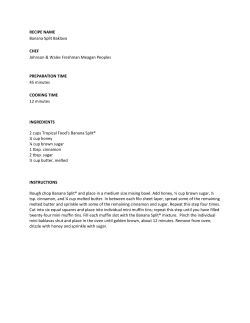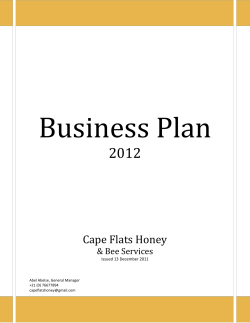
Bradycardia and Severe Hypotension Caused by Wild Honey Poisoning L D
Hellenic J Cardiol 2009; 50: 426-428 Case Report Bradycardia and Severe Hypotension Caused by Wild Honey Poisoning LAXMAN DUBEY, ARUN MASKEY, SHYAM REGMI Department of Cardiology, Shahid Gangalal National Heart Centre, Bansbari, Kathmandu, Nepal Key words: Bradycardia, hypotension, poisoning, wild honey. Manuscript received: December 16, 2008; Accepted: March 23, 2009. Address: Laxman Dubey Department of Cardiology Shahid Gangalal National Heart Centre Bansbari, Kathmandu, Nepal e-mail: dubeylax@yahoo.com Wild honey is taken as an alternative medicine for the treatment of gastrointestinal diseases as well as for coronary artery disease. However, wild honey made from the nectar of some species of rhododendron may be poisonous. The cause of the poisoning is the toxin grayanotoxin. Grayanotoxin is a naturally occurring sodium channel toxin that causes life-threatening bradycardia, hypotension, and altered mental status. Complete heart blocks may occur in some patients. We present an interesting case of bradycardia and hypotension due to wild honey ingestion. The symptoms, mechanism, and management of wild honey poisoning are discussed. H oney poisoning is caused by the consumption of wild honey (also known as “mad honey”) made by bees from some species of rhododendron.1 Wild honey is taken as an alternative medicine for the treatment of gastrointestinal diseases, such as gastritis and peptic ulcer disease, as well as for coronary artery disease. The cause of the poisoning is the toxin grayanotoxin. Grayanotoxin is a naturally occurring sodium channel toxin which induces increased parasympathetic tone.2 We report a case of wild honey poisoning where the patient visited our emergency room with bradycardia and severe hypotension. Case presentation A 56-year-old man visited our emergency room complaining of weakness, profuse sweating, nausea and dizziness. He mentioned that he developed such symptoms one hour after drinking approximately 30 ml wild honey mixed in water. He had a previous history of hypertension and dyslipidaemia, while three years previously a coronary angiogram had revealed doublevessel disease, for which he had been put on 426 ñ HJC (Hellenic Journal of Cardiology) aspirin, atenolol, atorvastatin and nitrates. On presentation, the patient was in a poor general state, profusely sweating with a heart rate of 43 beats per minute. He was conscious but complained of chest tightness, dizziness and nausea. He denied taking any overdose of the prescribed drugs. His blood pressure was 60/40 mmHg. The electrocardiogram showed sinus bradycardia at 43 beats per minute (Figure 1). His routine haematological and biochemical parameters were within normal limits. Echocardiography revealed mild mitral regurgitation and a left ventricular ejection fraction of 65%. Immediately, 0.5 mg atropine and parenteral normal saline (0.9% sodium chloride) were administered. A second dose of 0.5 mg atropine was given five minutes after the initial dose because heart rate and blood pressure could not be restored. Ten minutes later his heart rate increased to 70 beats per minute. Four hours later his heart rate was 99 beats per minute (Figure 2) and his blood pressure had increased to 110/70 mmHg. He was then monitored in the coronary care unit. The next day, the patient became clinically asymptomatic. His vital signs were not pathological and he was Wild Honey Poisoning Figure 1. ECG on admission, showing sinus bradycardia at 43 beats/minute. Figure 2. ECG after recovery, showing normal sinus rhythm at 99 beats/minute. (Hellenic Journal of Cardiology) HJC ñ 427 L. Dubey et al discharged on his previous medications without any complications. Discussion Honey poisoning is caused by consumption of wild honey made by bees from some species of rhododendron, such as Rhododendron luteum, R. ponticum, R. simsii.1 The cause of the poisoning is the toxic substance known as grayanotoxin, which is known to occur in the nectar, leaves and flower of rhododendrons growing in some hilly areas of Turkey, Japan, Brazil, some parts of North America, Europe, as well as in Nepal.3 Nearly 18 forms of grayanotoxins have been identified. The main one, grayanotoxin I, also known as andromedotoxin, occurs only in Ericaceae plants and is responsible for poisoning.4 For a long time, people have been taking wild honey as an alternative medicine for the treatment of gastrointestinal diseases such as gastritis and peptic ulcer disease. Additionally, it is believed that such honey reduces the risk of coronary heart disease and is also a sexual stimulant.5 Grayanotoxin binds to sodium channels in cell membranes, where it increases sodium channel permeability and inhibits repolarisation, thus maintaining the cell in a state of depolarisation. In particular, the increasing inward current and decreasing outward current of sodium on the cell membrane at the sinoatrial node weaken the action potential. Ultimately, a decreased action potential brings about sinus node dysfunction.6 It has been suggested that the sites of cardiac and respiratory actions of grayanotoxins are within the central nervous system, and the bradycardia is mediated by vagal stimulation at the periphery.7 The stimulation of the unmyelinated afferent cardiac branches of the vagus nerve leads to a tonic inhibition of central vasomotor centres with a reduced sympathetic output and reduced peripheral vascular resistance,7,8 leading to bradycardia, continued hypotension, and peripheral vasodilatation. Onat et al showed that the non-selective 428 ñ HJC (Hellenic Journal of Cardiology) muscarinic antagonist atropine sulphate alleviated bradycardia, while the selective M2-muscarinic antagonist AF-DX 116 restored heart rate.7 The toxic effects of wild honey poisoning are rarely fatal and last for no more than 24 hours. Generally, it induces dizziness, weakness, perspiration, salivation, nausea, vomiting, hypotension, bradycardia, atrioventricular block, and syncope.2 Fortunately, to date no cases of death have been reported. Low blood pressure responds to the administration of fluids, and sinus bradycardia and conduction defects usually respond to atropine therapy. The precise dose responsible for poisoning is not known, but in our case the patient had consumed approximately 30 ml of wild honey. It is important that honey poisoning should be kept in mind when previously healthy patients are admitted with unexplained bradycardia, hypotension, and atrioventricular block. Close observation and symptomatic treatment are all that is necessary in honey poisoning: however, the physician should be alert for sudden worsening of bradycardia and progressive conduction disturbances. References 1. Yavuz H, Ozel A, Akkus I, Erkul I. Honey poisoning in Turkey. Lancet. 1991; 337: 789-790. 2. Gunduz A, Turedi S, Uzun H, Topbas H. Mad honey poisoning. Am J Emerg Med. 2006; 24: 595-598. 3. Onat FY, Yegen BC, Lawrence R, Oktay A, Oktay S. Mad honey poisoning in man and rat. Rev Environ Health. 1991; 9: 3-9. 4. Hikino H, Ohizumi Y, Kanino C, Hashimoto K, Wakasa H. Subchronic toxicity of ericaceous toxins and rhododendron leaves. Chem Pharm Bull. 1979; 27: 874-879. 5. Sutlupinar N, Mat A, Satganoglu Y. Poisoning by toxic honey in Turkey. Arch Toxicol. 1993; 67: 148-150. 6. Seyama I, Yamaoka K, Yakehiro M, Yoshioka Y, Morihara K. Is the site of action of grayanotoxin the sodium channel gating of squid axon? Jpn J Physiol. 1985; 35: 401-410. 7. Onat FY, Yegen BC, Lawrence R, Oktay A, Oktay S. Site of action of grayanotoxin in mad honey in rats. J Appl Toxicol. 1991; 11: 199-201. 8. Brignole M. Vasovagal syncope and vasovagal disease. Hellenic J Cardiol. 2008; 49: 61-64.
© Copyright 2025


















